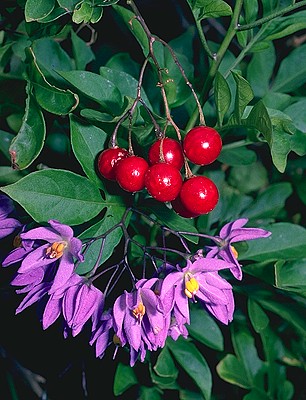
Synonymy
*Solanum seaforthianum Andrews, Bot. Repos. 8: t. 504 (1808)
T: cultivated in Britain from material introduced from the West Indies by Seaforth; holo: H.Andrews, loc. cit., t. 504, fide D.E. Symon, J. Adelaide Bot. Gard. 4: 67 (1981).
Description
Sprawling perennial shrub or climber, green; simple, non-glandular hairs on leaf margins, veins of lower leaf-surface and corolla margins and tips; glandular hairs on peduncles and pedicels; prickles absent.
Leaves ovate; lamina 4–13 cm long, 4–11 cm wide, concolorous, deeply lobed, the lobes often cut to midrib; petiole 2–4 cm long.
Inflorescence few–50–flowered; peduncle 1–6 cm long; rachis to 10 cm long; pedicels 10–15 mm long. Calyx 1.5–2.5 mm long; lobes broad, very short. Corolla deeply incised, 20–30 mm diam., mauve-blue. Anthers 2.5–4 mm long.
Berry globular, 8–12 mm diam., bright red. Seeds 2–3 mm long, reddish-brown, hairy.
Distribution and ecology
Native to West Indies; widely cultivated and naturalised in South and Central America and other tropical areas. In Australia occasionally cultivated as an ornamental in southern States; naturalised in Qld and N.S.W. in moist gullies and disturbed rainforest.
Common name
Brazilian nightshade, Potato creeper, St Vincent lilac
Relationships
A member of subg. Potatoe, species of which are usually creepers or vines with deeply lobed leaves and lacking spines or stellate hairs. American in origin.
Other species of this group in Australia are S. dulcamara, S. palitans, S. laxum, S. triflorum and S. tuberosum.
Notes
Berries reported poisonous to poultry, pigs, cattle, sheep and children.
Derivation of epithet
The species was cultivated in Britain from material introduced from the West Indies by Lord Seaforth (Francis Mackenzie Humberston, 1754-1815), governor of Barbados from 1801 to 1806. Lord Seaforth was responsible for the introduction of many living plants to the gardens of England and these are illustrated in early issues of Curtis' Botanical Magazine and Andrews' The Botanists Repository.
See: R.A.Howard (1979). Early botanical records from the West Indies, particularly Barbados: Ligon (1657) to Lord Seaforth (1806). Botanical Journal of the Linnean Society 79: 65-96.
Selected specimens
Qld: Yarraman, V.K. Moriarty 888 (BRI); Tolga scrub, D.E. Symon 4754 (ADW, CANB). N.S.W.: near Alstonville, S. Clark, J. Pickard & R. Coveny 1259 (NSW).
From the web
Further information on this species in NSW can be seen on the PlantNET site and information for WA can be found on the FloraBase site.
A photograph of this species by Hugh & Nan Nicholson can be seen on the Terania Rainforest Publishing Photo Library site.
A superb set of images of S. seaforthianum is available on the Plants of Hawaii site with background information on this species on the Pacific Island Ecosystems at Risk (PIER) site and there is a fact sheet with images accessible through the South African Weeds & Invasive Plants site.
Limited information and links for this species can be found on the Solanaceae Source site but there are photos of plants and images of herbarium specimens.







